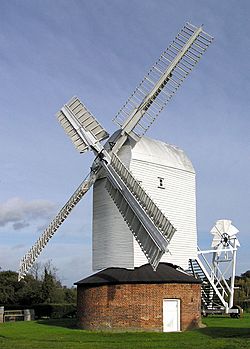Upthorpe Mill, Stanton facts for kids
Quick facts for kids Upthorpe Mill, Stanton |
|
|---|---|

Upthorpe Mill, November 2006
|
|
| Origin | |
| Mill name | Upthorpe Mill |
| Mill location | TL 971 733 |
| Coordinates | 52°19′20″N 0°53′28″E / 52.32222°N 0.89111°E |
| Operator(s) | Private owner |
| Year built | 1751 |
| Information | |
| Purpose | Corn mill |
| Type | Post mill |
| Roundhouse storeys | One storey |
| No. of sails | Four sails |
| Type of sails | Double Patent sails |
| Windshaft | Wood, cast iron Poll End |
| Winding | Fantail |
| Fantail blades | Eight blades |
| No. of pairs of millstones | Two pairs |
| Other information | Scheduled monument |
Upthorpe Mill is a special old windmill in Stanton, Suffolk, England. It is a type of windmill called a post mill and is protected as a historic site. This amazing mill has been fixed up and can grind corn again! It is also a Grade II* listed building, which means it is very important historically.
Contents
The History of Upthorpe Mill
How the Mill Was Built and Moved
Upthorpe Mill was built a long time ago, in 1751. When it was first built, it was a simple 'open trestle' post mill. This means its main support structure was open to the air. Later, in 1818, the whole mill was moved to where it stands today.
Changes and Upgrades Over Time
Over the years, Upthorpe Mill got some cool upgrades! Its original 'Common sails' were changed to 'Double Patent sails'. These new sails were more efficient. A round building, called a roundhouse, was added at the bottom to protect the main post. Also, a 'fantail' was put on the back. This clever device automatically turned the mill to face the wind, so it could always catch the breeze without someone having to do it by hand.
When the Mill Stopped Working
Towards the end of its working days, the mill only used one pair of sails. By 1918, the mill was no longer used for grinding corn. By 1937, it was falling apart and becoming very old and damaged.
Saving the Mill: Restoration Efforts
A person named Rex Wailes checked out the mill for a group called the Society for the Protection of Ancient Buildings. In 1938, they asked for money to fix it. In 1939, a mill expert named Amos Clarke, with help from Messrs Hunts of Soham, started repairs. They fixed the roof of the roundhouse and other parts.
The plan was to put in a new metal windshaft and new sails, but this work could not be finished because World War II started. During the war, the mill was painted grey. This was done to make it less noticeable from the air, as it was close to an air force base called RAF Shepherds Grove. The mill was used during the war, but it stopped working in 1946 because it was not making enough money.
More Repairs and New Owners
By the late 1960s, the mill was again falling apart. In 1979, emergency repairs were done by the Suffolk Mills Group. In 1986, a person named Richard Duke bought the mill. He worked hard to restore it, and by 1990, the mill could grind corn again! In 1993, Peter Dolman bought the mill and continued the restoration work.
How Upthorpe Mill Works
Upthorpe Mill is a post mill that stands on a single-storey roundhouse. It has four Double Patent sails. These sails are connected to a wooden shaft called a windshaft, which has a metal end.
Inside the Mill: The Grinding Process
The windshaft turns a large wooden wheel inside the mill called a brake wheel. This wheel has iron teeth that connect to another wheel, a cast-iron wallower. The wallower is on a wooden upright shaft. At the bottom of this shaft, a large cast-iron wheel called the great spur wheel turns. This wheel then drives two pairs of millstones. These millstones grind the corn into flour.
The back of the mill has been made longer to make room for a special machine called a wire machine. The eight-bladed fantail is on the back ladder. It uses gears and shafts to turn the mill into the wind automatically. On the main post of the mill, you can see the words R Rix 1807 carved into the wood.
Millers of Upthorpe Mill
These are some of the people who have operated Upthorpe Mill:
- William Bryant (1939–1946)
- Richard Duke (1990–1993)
- Peter Dolman (1993–2002)
- John Craven (2002–2004)
- Dominic Grixti (from 2004)
Public Access
Upthorpe Mill is a private property and is not open to the public.

